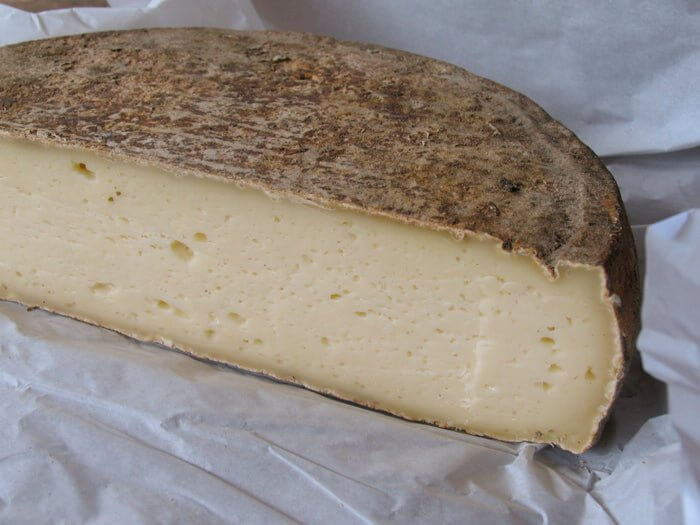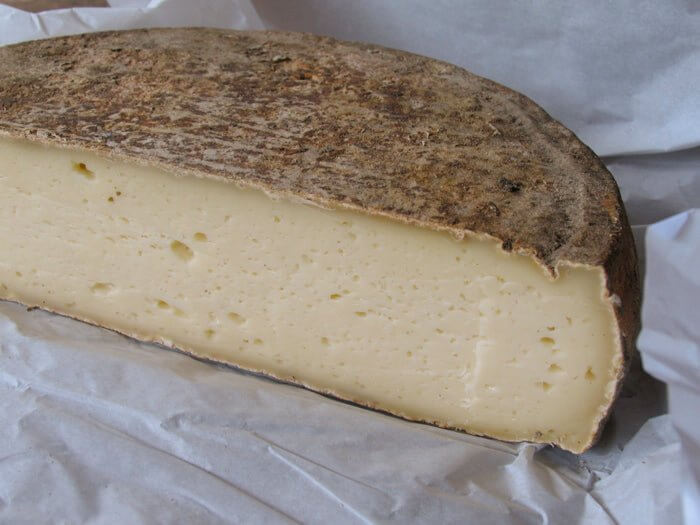
Tomme Style Cheese Recipe
-
Yield
4 Pounds
-
Aging Time
~2 Months
-
Skill Level
Intermediate
-
Author
Jim Wallace

Tomme Style Cheese Recipe Info
Tomme: Alpine Origins
History of Tomme Cheese
Tomme de Savoie Style
Farmstead & Cooperative Production
Ingredients
Total price for selected items: Total price:
Instructions
A Recipe For Making Your Home Tomme
The photos below are actually for a double batch using 8 gallons of milk, if you prefer to make an 8 gallon batch, just double my guide amounts below. With either batch size, this cheese has a somewhat open texture with medium moisture.
-

Acidify & Heat Milk
Begin by heating the milk to 87°F (31°C). You do this by placing the milk in a pot or sink of very warm water. If you do this in a pot on the stove, make sure you heat the milk slowly and stir it well as it heats.
Once the milk is at 87°F, the culture can be added. To prevent the powder from caking and sinking in clumps, sprinkle the powder over the surface of the milk and then allow about 2 minutes for the powder to re-hydrate before stirring it in.
The balance for this cheese is toward the mesophilic end for early acid and then the thermophilic will support the ripening phase.
The milk, with culture added and stirred in well, should set still for about 1 hour while the culture begins its work.
-




Coagulate with Rennet
Once the culture has ripened the milk, add about 1/2 tsp (2.5ml) of single strength liquid rennet. Stir this in gently, but thoroughly, with an up and down motion for about 1 minute. The milk should then come to a complete rest with no movement while the curd forms.
The milk now needs to set still for 30 minutes while the culture works and the rennet coagulates the milk. You should note the milk beginning to thicken at about 10 minutes, but wait until you see a good curd develop, as shown below (about 30 minutes from rennet addition). The thermal mass of this milk should keep it warm during this period. It is OK if the temperature drops a few degrees during this time.
When the curd has formed well, it will pull away from the vat side cleanly, showing clear whey at the separation. By inserting the flat blade of a knife below the curd surface and lifting, you should find it breaks clean, as shown in the photos above. The whey that fills into this split should not be too clear (cut too late) or too milky (cut too early).
If your test shows a good curd formed, then it is time to cut and release the whey.
-




Cutting Curd & Release Whey
You can now cut the curd to 1/4-3/8”, and stir gently for 10-15 minutes to release moisture and keep the curds separate. This should be a very gentle stir initially. I do my cut here by first cutting a 3/4-1 inch cross cut (as shown below), allowing this to rest for about 2-3 minutes and then using a large thin wired whisk (this is just something I found in a kitchen store that emulates the "Spino" and "Cheese Harps" commonly used for cutting in Italy and France) to break these pieces into even curds (as even as possible).
Initially the curds will be quite soft.
-




Cook the Curds
Our next step is to scald/cook the curd to 98°F over 15 minutes.
I choose to do this by allowing the curd to settle, then removing 40% (original milk volume) of whey. I then add back 15% (original milk volume) of water at 120°F to raise to the scald temp of 98°F, doing this slowly over 15 minutes. This will effectively remove some of the lactose (food for culture) and thus will reduce the rate and degree of acid development. This slower acid development will have a role in the final texture development of the cheese.
The final curds should be cooked well through and should be examined to make sure that enough moisture has been removed. A broken curd should be firm throughout and the curds should have a moderate resistance when pressed between the fingers.
When this point is reached, the curds can be allowed to settle under the whey.
-



Remove Whey & Mold Curds
The whey can be ladled from the vat until about 1 inch remains above the curd mass. The curd mass should then be given a good stir to free the curds from matting. The curds along with the remaining whey can now be transferred to forms. The forms can be lined with butter muslin or, as I show below, I cut a small piece of the (U3) Disposable Cheese Cloth - just large enough to cover the bottom of the mold.
-




Pressing
This cheese requires very light pressing due to its high moisture and warmth when going into the mold:
- Use 4-5 lbs for 3-4 hours or, as in the photos below, working with multiple cheeses, just the weight of 1 cheese on top of another. Flip and reverse the positions frequently, with the first at about 30 minutes post molding.
- At each turn you will notice the cheese has formed a smoother surface and rests lower in the mold.
- Hold the cheese overnight at room temperature with no weight to allow the final acid development before salting the cheese.
The rate of whey running off is simply a matter of drops and not a stream of whey being released. This is a good rate of whey removal during pressing and will slow even more as the residual free moisture is released. You should see tears of whey weeping from the form very slowly.
-

Salting
You should already have a saturated brine prepared for salting this cheese.
If not, you will find all of the details you need on brining here
A simple brine formula is:
- 1 gallon of water
- 2.25 lbs of salt
- 1tbs. calcium chloride (30% solution)
- 1 tsp. white vinegar
The cheese now needs to be placed in the brine for about 8-10 hours. The actual time will depend on the final moisture in the cheese - less time for a moister cheese.
The cheese will float above the brine surface, so sprinkle another teaspoon or two of salt on the top surface of the cheese.
Flip the cheese and re-salt the surface about half way through the brine period.
OR, you could also dry salt this cheese at the rate of about 2% salt by weight. Apply this in several small doses over 2-3 days, allowing the salt to sink in before turning and salting again
At the end of the brine bath or dry salting, wipe the surface and allow the cheese to surface dry for a day or two. The surface will darken somewhat during this time.
-



Aging
The character of this cheese depends on a natural rind being formed and allowing natural molds to grow. This is typically the result of natural molds that settle on the surface of the cheese.
The cheese can then be placed into your aging space at 52-56°F and 80-85% moisture (I prefer the higher moisture).
The cheese can now be aged for 6-8 weeks and it will ready for your table. A longer aging will make a more characterful cheese.
During the aging process, you will notice a rather wild progression of molds. It is common as well as desirable to have an initial furry mold (a form of mucor) along with a base white mold developing. As time passes and the hair like mold gets matted down with turning and rubbing the surface, you will see a darker mold surface developing. In the end, the mold may become quite mottled, perhaps with some spots of mimosa yellow or bright red, and these are quite typical and usually a sign of good, diverse flora in your aging space.
If you have been making cheese for some time or bringing a variety of cheese with natural rinds into your aging space, you will probably see a nice evolution of mold growth.
Your first attempts at this may not be quite as dramatic but some natural mold should develop. If the cheese or aging room is too dry, you may find the surface growth is very slow and limited. If it is too moist, you may find a dominating blue /green mold that develops and corrections should be made to avoid this.
Little needs to be done to these during aging other than turning the cheese every couple of days and a slight rub to knock down the mold and spread it over the surface.
Cheese Making Supplies
Related Products
You May Also Like




































